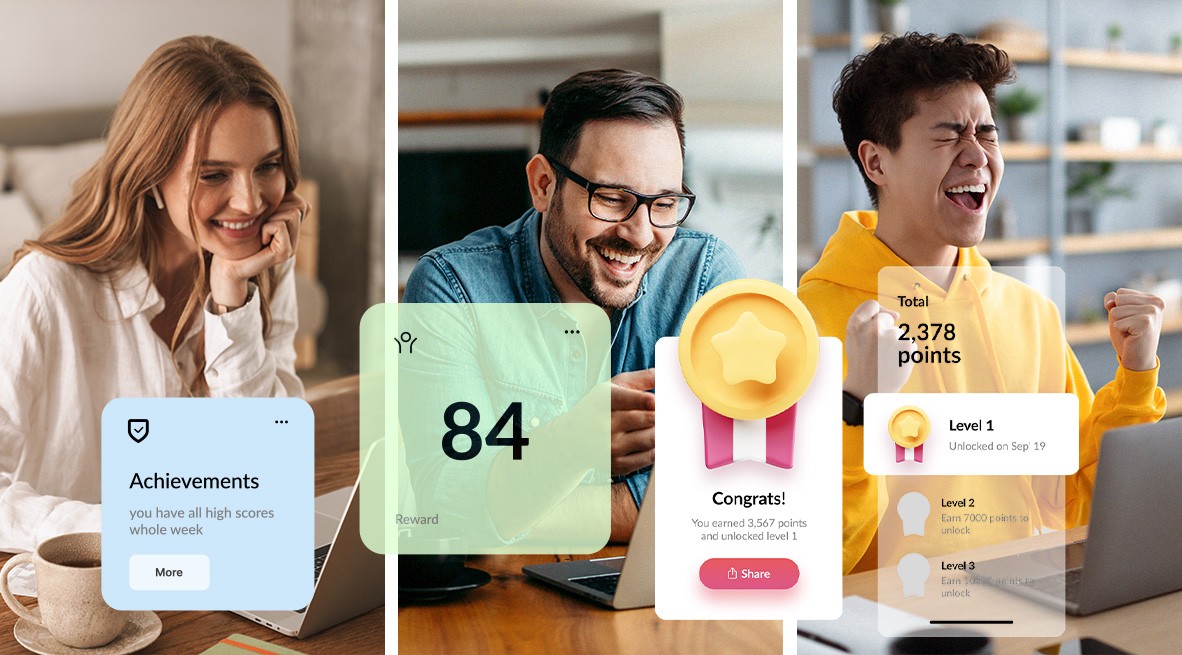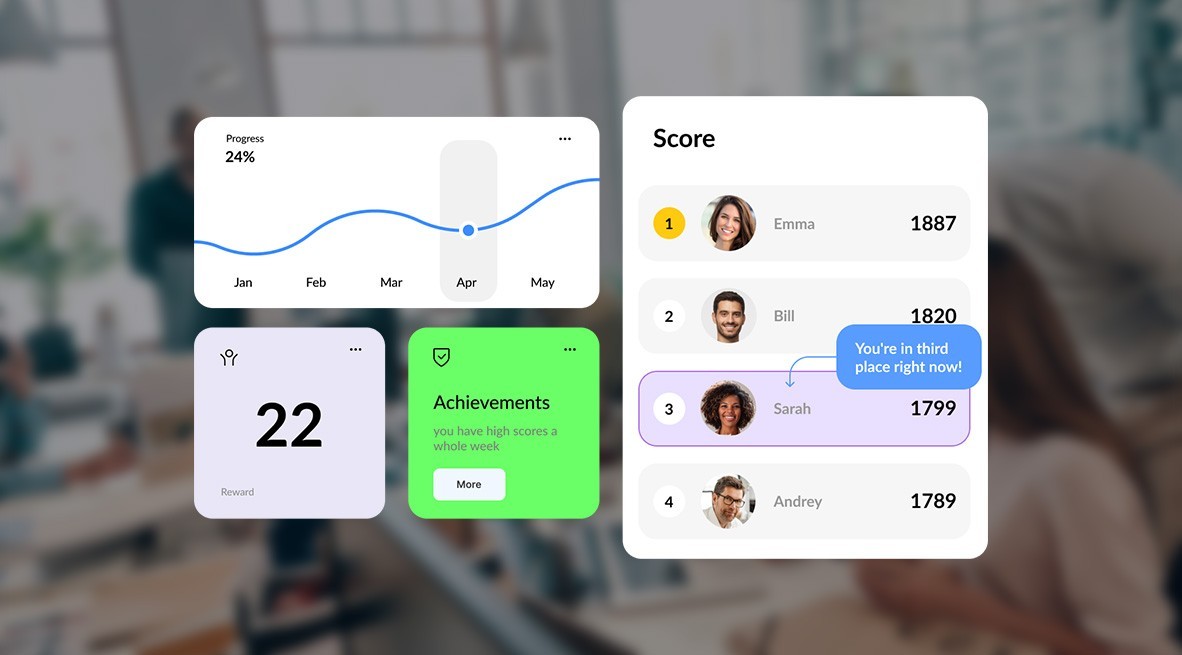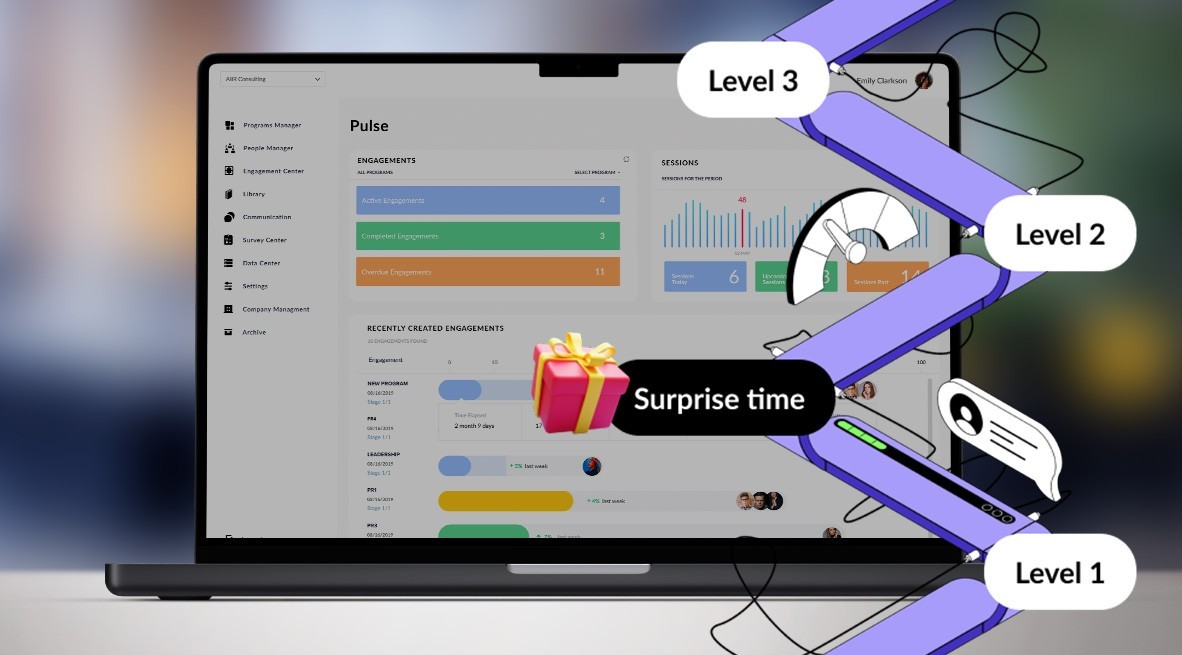What is gamification in eLearning?
Meet John — a disengaged yawning “Stress Management” course spectator, who’s passively sitting out the presentations lovingly crafted by his company, whining about wasting time. Mastering conflict resolution is out of the picture, of course, prompting the company to question the need for the custom LMS at all.
Fast forward to a few months and some upgrades later and there is our John taking the initiative to find the time to do another quiz, striving to level up and outdo that know-it-all Mike from the accounting department. And, by the way, John has been handling stress remarkably well for a month now.
What’s changed? As you’ve clicked on this article you already know the answer — the learning excitement stems from introducing gamification.
So, what exactly is it? Did the company have to design a wholesome game to help John unleash his inner child?
The answer is definite, though often not obvious: although “game” and “gamification” are homonyms, the latter implies only the use of certain game mechanics and elements with the goal of making the transfer of knowledge more exciting and engaging, yet efficient.
Therefore, incorporating gamification elements into your solution does not mean automatically forcing users to play games and apply clever strategies. On the contrary, gamification, with its elements seamlessly integrated into the overall educational concept and training program, is only a supporting tool to achieve goals, not an objective in itself.
What makes gamification so trendy?
In 2020, the global education gamification market was valued at USD 697.26 million, and it’s expected to hit an impressive USD 4144.97 million by 2027. Moreover, 70% of the world’s largest companies, known as the “Global 2000”, have already started using gamification in their corporate training in some form. And if you’re wondering why this is happening, the stats provided by Zippia make it crystal clear:

70% of the U.S. workforce lacks commitment to their work

Companies using gamification are 7 times more profitable than their counterparts

Companies that have successfully engaged employees have a 22% boost in profitability, a 21% in productivity, and a 10% in customer satisfaction rates

90% of employees believe that gamification enhances their productivity in professional settings

72% of employees say that gamification serves as a great motivator, driving them to work harder

Employees experience an increase of 48% in engagement in gamified tasks and projects

Adult learners have an 11% boost in scores on factual knowledge assessments enhanced with gamification
Key business objectives that can be achieved through gamification
To incorporate the gamification elements effectively, it is crucial to start by defining the goals you will align the gamified experience with. Such objectives may include:
For eLearning service providers:
- Attracting more learners with engaging courses. Gamification can create interactive and enjoyable learning experiences that entice learners to actively participate.
- Reducing churn rate. Churn rate refers to the rate at which learners leave the eLearning platform. Gamification can play a significant role in improving user retention through increased motivation levels and social mechanisms like badges, points, or leaderboards.
- Fostering employer satisfaction. When employers see their employees actively engaging in training and improving their skills, they are more likely to continue the partnership with the eLearning company and view the eLearning platform as worthy of more and more investments.
For businesses:
- Enhancing skills and knowledge. Training effectiveness is vital for companies as it directly affects employees’ performance and efficiency. So, gamification elements can be strategically integrated into training courses to improve knowledge retention and skill development for their work roles.
- Fostering a healthy team environment. Friendly team or individual competitions drive employees to meet, collaborate, get to know each other, and communicate in a positive setting. Besides, they help employees understand and adopt company values in a fun and engaging manner.

- Demonstrating alignment with technology trends. By integrating gamification into corporate training, organizations show their commitment to staying up to date with technology trends and providing innovative learning experiences for their employees.
Elements that make gamification in eLearning a success
While the wide variety of elements that make up gamified eLearning can be classified into various categories, we will explore the two main ones.
The first approach organizes all game mechanics into 4 specific groups:
1. Progressive achievement
- Unlocking levels or stages as the learner progresses through the courses or lessons.
- Advancement on leaderboards and progress bars, as well as earning badges, points, and rewards for completing challenging tasks.
2. Social interaction
- Joining online forums to collaborate with fellow learners.
- Competing with others in learning challenges or quizzes.

3. Immersion experience
- Engaging in virtual real-life scenarios and simulations for practical learning.
- Role-playing as characters.
4. Others
- Incorporating a time-based challenge where learners must complete tasks within a specific time frame to earn rewards.
- Introducing a chance element, such as a spin-the-wheel game, to determine the type of reward or penalty.
Another way to categorize eLearning gamification elements is by the type of motivation they target: extrinsic and intrinsic.
1. Extrinsic motivation
This kind of motivation refers to the desire to be engaged in an activity because of external rewards. When talking about gamification in eLearning, these elements typically involve points, awards, prizes, virtual trophies, and the rankings of users based on their performance in the training program.
2. Intrinsic motivation
This motivation, on the other hand, refers to the inner desire to do something and the enjoyment received from the activity itself. Some common examples of intrinsic eLearning gamification elements include: thought-provoking challenges, puzzles, engaging storylines that make users feel connected to the experience on a personal level, activities that encourage users to be creative and allow them to have a certain degree of autonomy in the gamified experience, and those that give users a sense of growth and achievement, like timely feedback and clear progression paths.
However, it’s worth noting here that when taken separately, all those elements are unlikely to do the trick, as gamification is about designing a meaningful and wholesome learning experience that can hardly be achieved through rewards and points alone.
It takes a nice storytelling context that engages learners and connects the educational content to the learners’ interests. Clear goals for every activity, appropriate levels of difficulty for every learner, constructive and actionable feedback, and lots of small incentives that provide learners with recognition and satisfaction.
Make gamification work for your company
If you’re on the lookout for ways to engage, motivate, and entertain your learners to enhance the value of your training – let us show you what magic integrating gamification into your eLearning platform can do.
Benefits of using gamification in eLearning: Real-life scenarios
Given that gamification not only makes this world more colorful and enjoyable, but is also perfect for tackling real business challenges, let’s take a closer look at the ways we use gamification for solving some specific problems that many businesses face.
The first scenario
Business’s cry for help:
“The churn rate on our platform has gone up, users are dropping out, and our B2B segment is on the verge of collapse because fewer organizations are willing to pay for our learning management systems to train their staff.”
Solution through gamification
First off, thanks to gamification, even those learners who study only while waiting for a train at a station will become more engaged and interested in seeing what comes next.
And secondly, since learning will ensure employees don’t feel overwhelmed by complex courses, the companies that order learning management system development will also appreciate the outcome, witnessing employees learn swiftly and efficiently .

The second scenario
Business’s cry for help:
“Even though each project is controlled by its own project manager, we’d still like to impartially assess the skills of our long-term employees to identify areas where additional training, certification, or even job cuts might be beneficial. However, we’re well-known for our laid-back atmosphere, and the last thing we need is any tension with tests and exams.”
Solution through gamification
For organizations seeking a swift and comprehensive evaluation of their employees’ knowledge, whether theoretical or practical, gamified elements offer an ideal solution for stress-free testing, ensuring that employees even remain unaware of being evaluated. So the aim of not catching anyone off guard but rather gathering valuable data for managers to address any issues effectively can be achieved easily and painlessly.
The third scenario
Business’s cry for help:
“We must regularly adjust our policies and procedures to keep up with new regulations and process upgrades. But whenever these changes take place and employees get notifications about the updates on our inner educational platform, we can hardly measure their understanding and even control who has checked out the updates and who hasn’t.”
Solution through gamification
Introducing gamification will help teach those important procedural changes in a fun and interactive way through online courses and activities. Plus, the implementation of a real-time tracker will demonstrate how everyone’s doing and make sure that everyone is acquiring new skills on time.
Best practices of using gamification in eLearning
A poorly executed gamification strategy without thoughtful consideration can do more harm than good. According to Zippia’s disheartening statistics, about 80% of gamification initiatives in the workplace fall short of achieving a company’s objectives, primarily due to inadequate planning, design, and a lack of creativity and meaning.
At the same time, when done right, it becomes a rewarding experience for everyone involved. For instance, by following these practices that we apply at Oxagile, you can expect the gamification to bring a rise in the number of daily active users, an improvement in course completion rates, and a substantial boost in engagement, learning efficiency, and overall user satisfaction.
1. Comfortable innovation
Too much innovation is not necessarily a good thing, as it can have a reverse effect on both those who implement it and those whom it targets. In the context of gamification, this can be understood as too many diverse and confusing gamification features, which might lead to decreased engagement. This is particularly critical when dealing with the B2B sector, as businesses tend to be cautious and skeptical of experimental approaches. Therefore, a user-centered approach and simplicity should be prioritized to ensure a balance between gamification-powered engagement and user comfort.
2. Thinking through the gamification tactics
When implementing gamification in eLearning, it’s essential to carefully plan a comprehensive scenario from start to finish, rather than randomly add several gamification elements that might confuse users. At Oxagile, we achieve this cohesion by thinking through the logic of every step and every activity, as in our recent gamification project for an IT company, where we didn’t just add a few elements but built the entire logic of corporate training on gamification, redefining all courses and designing a playing field to form a well-structured system with branches in different areas of focus.

3. Deep understanding of your audience
While this principle sounds like something out of a first-grade marketing class, the importance of truly connecting with users’ preferences, behaviors, and learning styles is vital. Personalizing eLearning gamification boosts retention and gets users excited to be active participants. So regularly assessing and analyzing the data about your target audience and their learning preferences will help customize the gamification process and ensure the achievement of the set business goals. If you’re curious to know more about the ways data analysis can benefit eLearning platforms, our experts stand ready to be your guides.
Conclusion
Our brains’ love for solving puzzles and overall excitement for rewards, spiced up with an engaging interface and interesting storytelling, make gamified content so compelling for our attention, that positive emotions from studying become guaranteed. This fact certainly does not go unnoticed by thousands of companies worldwide that, as evidenced by the above statistics, actively embrace gamification throughout different processes in different departments.
Here at Oxagile, we also place significant importance on the advantages that gamification can offer, and we are eager to provide you with comprehensive insights into its mechanics and intricacies.
And since our expertise in EdTech extends beyond gamification alone, we can assist you in elevating every aspect of your educational product. If you feel like exploring how Oxagile can bring value to you, don’t hesitate to reach out to us, and we’ll share our expertise with you.


























